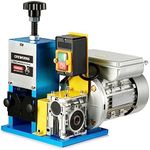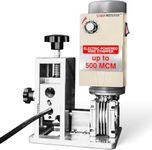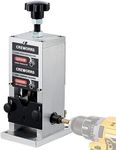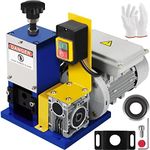Buying Guide for the Best Wire Stripping Machines
Choosing the right wire-stripping machine can make your work with electrical wires much easier, faster, and safer. Whether you’re a hobbyist, a small business owner, or working in a larger industrial setting, the right machine will help you strip insulation from wires efficiently without damaging the wire itself. To find the best fit, it’s important to understand the key features and specifications that matter most, and how they relate to your specific needs and the types of wires you’ll be working with.Wire Gauge CapacityWire gauge capacity refers to the range of wire thicknesses that the machine can handle. This is important because using a machine outside its capacity can damage both the wire and the machine. Wire gauges are measured in numbers, with lower numbers indicating thicker wires. Machines are often divided into those that handle fine, medium, or heavy-duty wires. If you mostly work with thin wires, a machine designed for small gauges is best, while larger industrial wires require a machine with a higher capacity. Consider the most common wire sizes you’ll be stripping and choose a machine that covers that range.
Manual vs. Automatic OperationWire-stripping machines come in manual and automatic versions. Manual machines require you to turn a handle or crank, while automatic machines use a motor to do the work for you. Manual machines are usually simpler, more portable, and suitable for occasional or light use. Automatic machines are faster and better for high-volume or frequent stripping tasks. Think about how often and how much wire you need to strip—if it’s just a few wires now and then, manual may be enough, but for regular or large-scale jobs, automatic is more efficient.
AdjustabilityAdjustability refers to how easily you can change the machine’s settings to accommodate different wire sizes and insulation types. Some machines have fixed settings, while others allow you to fine-tune the blade position or pressure. Greater adjustability is important if you work with a variety of wire types and sizes, as it helps ensure clean stripping without damaging the wire. If your work involves many different wires, look for a machine with easy and precise adjustment options.
Blade Quality and ReplacementThe blade is the part of the machine that actually cuts through the insulation. Blade quality affects how cleanly and efficiently the machine strips wires, and how long the blade lasts before needing replacement. High-quality, durable blades are important for frequent use and for stripping tougher insulation. Some machines make it easy to replace or sharpen blades, which is helpful for long-term maintenance. If you expect to use the machine often or on tough materials, prioritize machines with strong, easily replaceable blades.
Portability and SizePortability and size refer to how easy it is to move and store the machine. Smaller, lighter machines are easier to carry and fit in tight workspaces, making them ideal for home use or jobs that require moving around. Larger, heavier machines are usually more stable and suitable for fixed locations or industrial settings. Consider where you’ll be using the machine most often and whether you need to move it frequently.
Safety FeaturesSafety features help protect you from accidental cuts or injuries while using the machine. These can include blade guards, emergency stop buttons, and non-slip bases. Safety is especially important if you’re new to wire stripping or if the machine will be used in a busy environment. Look for machines with clear safety features if you want extra peace of mind during operation.



















